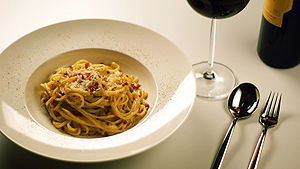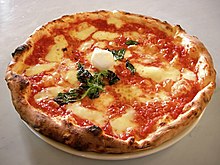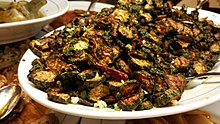While Italian cuisine is known around the world for dishes such as pizza and pasta, the domestic cuisine of Italy itself differs a lot from internationalized Italian dining. There are also regional variations that even a century and a half of a unified Italy and increased internal migration have not yet fully leveled.
| Cuisines of Europe British & Irish • French • German (Bavarian • Franconian) Georgian • Greek • Italian • Nordic (Finnish) • Portuguese • Russian • Spanish |
Understand
edit
Some Italian culinary traditions go back to the Roman Empire, became highly developed in Medieval and Renaissance Italy, and came to influence French cuisine. However, several of the ingredients stereotypically associated with Italian food, in particular tomatoes, originate in the Americas and did not reach Italy until the Italian Christopher Columbus sailed the ocean blue.
Italy was not unified until the 19th century, and regional pride is strong. Ingredients and cooking methods vary between regions. In a real sense, it can be said that in Italy, there is no such thing as "Italian cuisine", but rather, multiple styles of local cuisines that differ from one region to the next, and sometimes even from one village to the next. In general, northern Italian cuisine has similarities to Central European cuisines, in which animal fats such as butter and lard dominate. Southern Italy has more of the typical Mediterranean cuisine, based on olive oil, tomatoes, garlic and sub-tropical fruits.
Italian cooking has spread to places such as the United States, Canada, Argentina, Australia, and also to other European countries including Germany, Greece and the United Kingdom through Italian emigration. It is mostly Neapolitan pizza and various Southern Italian pasta dishes which have been popularized worldwide, owing in part to the fact that Southern Italy was poorer and therefore produced more emigration than Northern Italy during the 19th and 20th centuries. Moreover, many dishes were heavily modified in the diaspora to suit the local palates, and bear little resemblance to the original Italian versions; the prevalence of meatballs in Italian-American cuisine for instance is not found anywhere in Italy. Ironically enough Southern Italian cuisine sometimes took the "roundabout way" in getting to Northern Italy as German holidaymakers accustomed to Southern Italian food made by migrant workers back home took to vacationing in the northern parts of the peninsula en masse in the 1950s and demanded what they thought to be typical "Italian food".
In general, you can expect every place you visit in Italy to have its own local specialties. If you want to seek them out, look for restaurants serving cucina tipica and patronize local bakeries as well.
Ingredients
edit- Seafood (frutti di mare): While the Mediterranean is overfished, fish (pesce) and seafood are served in traditional dishes (cucina tipica) of coastal Italian communities.
- Meat (carne): Italy is particularly famous for cured meat, including prosciutto, mortadella and salame, and air-dried beef called bresaola. Steak is famously charred in Tuscany (bistecca alla fiorentina), pork (maiale) — especially in the form of wild boar (cinghiale) — is considered a delicacy, and many types of fowl are prepared in various ways.
- Cheese (formaggio): Italy has a variety of hard and soft cheeses. The generic word for cheese is formaggio. Pecorino (many varieties) is sheep cheese. Many Italian cheeses are made from cow's milk, and mozzarella is made from the milk of the European buffalo (mozzarella di bufala). Creamy mascarpone is often used in pastries, and ricotta is used in both savory and sweet items.
- Fruit and vegetables: (frutti, verdure) In the south, citrus fruits are ubiquitous. While tomatoes (pomodori) were unknown in Europe before the Age of Discovery, they are extremely common in today's Italian cuisines, especially in the South. Garlic (aglio) and onions (cipolle) are also important bases of much Italian food. Green leafy vegetables are typically used in mixed salad (insalata mista) and in soups such as zuppa di verdure (literally, "greens soup") and ribollita in Tuscany. Italian fruits and vegetables, as well as those imported into Italy, are of excellent quality. Dessert in ristoranti and trattorie in Italy as well as at Italian homes is quite often fresh fruit, with or without grappa or a liqueur.
- Pasta is a staple dish of Italian cuisine, except in the northernmost regions. There are hundreds of different forms of pasta, and depending on where in Italy you are some may have different names. Interestingly, spaghetti bolognese is rarely served in Italy — this sauce is known as ragù and mostly accompanies other forms of pasta.
- Bread (pane): In addition to being ubiquitous as an accompaniment to the meal, bread is a typical ingredient in zuppa. Zuppa is usually translated as "soup", and indeed in Tuscany, there is a very popular soup of bread and vegetables called ribollita. However, zuppa inglese ("English soup") is a dessert based on lady fingers (pieces of sponge cake) which are soaked in liqueur. It's definitely moist with custard and liqueur but not a soup in the English-language sense. However, the bready element in the dessert is soaked with liquid, as bread is soaked with liquid when inserted into soup.
- Rice (riso) is more common than pasta in the northernmost regions of Italy, and is often used in risotto.
Breads
edit
In Tuscany, bread (pane) is traditionally made without salt. In every other region, you can expect some salt in your bread, though not more than in other countries.
Aside from the loaves of Italian bread that many Italians buy twice a day, cornetti (croissants) are popular for breakfast and sold both in bakeries (panifici) and bars (bar). Cornetti are widely available plain (vuoti), cream-filled (con crema) and filled with apricot jam (con marmellata di albicocche).
Two items closely related to bread are focaccia and pizza. Focaccia, which is essentially a form of oily bread with other items in the dough, is a specialty of bakeries. It may or may not be thinner than typical bread, but even at its thinnest, it is not likely to be nearly as thin-crust as Italian pizza. It is available in both savory and sweet flavors. Possibilities are greater than could be stated here, but common ones include onions, rosemary (rosmarino), potatoes (patate), salami (salame), artichokes (carciofi), tomatoes (pomodori), and late in wine harvesting season, grapes (uva).

Unlike focaccia, pizza is not normally available in bakeries. Making it requires a pizza oven, and pizzas (pizze, in Italian) are served at pizzerie. There are at least two well-known types of pizza in Italy: Neapolitan pizza, (pizza napoletana) and Roman pizza (pizza romana). Italian pizza is based on a crust of excellent bread. In Naples and Campania, generally, pizza is very thin-crusted, and the most common variety is pizza margherita, which is topped with tomatoes, fresh mozzarella di bufala and fresh basil (basilico), forming the three colors (red, white and green) of the Italian flag. The most common item to add to these three ingredients is prosciutto. Neapolitan pizza is saucy and must be eaten on a plate with a knife and fork; do not even think about ordering it to go and trying to eat it outside, as all the ingredients will fall away from whichever side you pick up, and you will make a mess. In Rome, pizza is available with several toppings and is still thin-crust, but not as thin as Neapolitan pizza. Notably, not all pizza toppings include tomatoes or tomato sauce; pizza bianca may or may not include cheese and can have various other ingredients, but not tomatoes; pizza quattro formaggi has four cheeses and may or may not include tomatoes. An entire pie of Neapolitan or Roman pizza is normally eaten by a single person as a meal. Beer is a common accompaniment, more common than wine. While pizza is probably the best-known Italian food, it took until the 1950s for it to become widespread in the North of the country. The legend has it that Italian migrant workers from the South had introduced Germans to the taste of pizza and when they crossed the Alps in their VW Käfer, they demanded "Italian food", which clever businesspeople quickly supplied in the form of pizza, a dish previously hard to find around Venice or Milan.
Italy also has a high standard of sandwiches, called panini (singular: panino — never ask for "un panini" or "paninis" in Italy). You can get them in bars, but the highest quality is usually in paninoteche (singular: paninoteca) — dedicated sandwich shops. They are generally made with good bread and excellent vegetable, meat and cheese ingredients.
There are also baked goods that are often eaten for dessert, such as biscotti di Prato, which in Tuscany are typically dunked into powerful vin santo (so-called "holy" dessert wine). Biscotti di Prato are available in boxes in markets (mercati) and supermarkets (supermercati) as well as freshly baked at panifici and at pasticcerie (pastry shops, or bakeries that specialize in pastries).
Pastries
edit
In addition to savory food, there are wonderful Italian pastries, especially in Naples and other points south but also in places like Siena, which aside from pan-Tuscan treats, also has some local specialities, most notably panforte, a kind of very dense cake. Fresh pastries are best purchased at pasticcerie (singular: pasticceria), which are pastry bakeries. The exception is in fact dense confections such as panforte and torrone (nougat), which do not go stale as quickly and are often sold by stores that specialize in similar items, and also in supermarkets.
Gelati and sorbetti
editOf course, Italy is famous for gelato and sorbetto. Gelaterie typically provide a selection of both. Numerous flavors are commonly available. In addition, if you are feeling more indulgent, you may order a fruit salad (macedonia di frutta) with gelato. Although English speakers typically use "gelato" to refer specifically to Italian-style ice creams, in Italian the word is a generic term for any type of ice cream.
To order gelato, you need to make three decisions: whether to have a cup (coppetta) or a cone (cono), what serving size, and what flavors. In a large shop, you will likely be expected to pay the cashier first, get a receipt for paying that shows which size you ordered, and then take that receipt to the person behind the counter, who will scoop your choice of flavors. On a hot day, remember that gelato melts fast, so a cup may be a less messy option.
In most gelaterie, even if you order the smallest size, you can get two flavors, and you might get three with a larger size. If the shop isn't busy, you can ask the staff what they recommend as a good combination, and perhaps for a taste of one or two before you make up your mind. The flavors are usually arranged with the fruit flavors on one side of the case and the milk-based creamier options, such as chocolate and nut, on the other side, because Italians don't normally mix the two. Some of the most common flavors are chocolate (cioccolato), hazelnut (nocciola), chocolate chip or swirl (stracciatella), pistachio (pistacchio), strawberry (fragola), lemon (limone), and coffee (caffè). If you're looking for an unusual flavor that you're not likely to find back home, try the sette veli gelato, which combines multiple types of chocolate gelato, or ricotta stregata, which is made with ricotta cheese.
Beverages
edit- Wine: Italy is famous for its wine (vino). Wine is used quite often in cooking as well as to drink with the meal.
- Prosecco is a sparkling white wine with a dry and somewhat sweet taste. A cheaper alternative to French champagne.
- Strong alcoholic beverages from Italy include amaretto (almond liqueur), grappa (liquor distilled from wine leavings) and limoncello (sweet though strong lemon liqueur).

- Coffee: Italy is home to espresso and many different types of coffee. In Italy, cappuccino is served only at breakfast. Other times of the day, espresso and caffè latte are popular. (Never call caffè latte "latte" in Italy, as latte means "milk".) Italian espresso is generally not scalding hot, so the whole thing can be swallowed at once. You won't see the locals walking around the city with a cup of coffee in hand and occasionally taking little sips. Just go into the coffee shop or bar, get your espresso, drink it, and go back out. The whole process can take less than two minutes.
- Beer: Beer (birra) is also popular in Italy. Peroni and Moretti are the most common Italian beers, but there are also many smaller breweries. Not surprisingly, there is more brewing in the northern part of the country, which is climatically and quite arguably culturally more similar to Austria than to Sicily.
- Tea: Italy is not a huge tea-drinking country, but tea (tè) is nevertheless commonly available in bars or other places where you might have breakfast, such as a pensione (bed and breakfast).
- Hot chocolate: Hot chocolate (cioccolata calda) in Italy is dark and of generally excellent quality, and is also commonly available with breakfast.
Traditional courses
editIn Italian trattorie and ristoranti, you may be presented with the option of a menù (prix fixe menu). The traditional Italian meal, for lunch and supper, has the following courses:
Antipasti (appetizers): These are often cured meats, but can also be small vegetable plates or such items as arancini (rice balls). Crostini (small slices of bread with toppings) are also quite common. This is an optional course and may or may not be on your menù.
Primo piatto, sometimes listed as pasta o minestre (pasta or soup): Generally, the soups or pasta plates are traditionally of comparable size, quite a lot smaller than the main dish, so as to leave you with room for the secondo.
Secondo piatto: This is most commonly a red meat or poultry dish, though fish and seafood are also common and vegetarian secondi do exist (for example, melanzana alla parmigiana — eggplant parmigiana — is sometimes served in a large portion as a secondo, though it can also be a contorno). The secondo is the main dish.
Contorno: Contorni are vegetable side dishes, sometimes served after the secondo and sometimes alongside it. This is the point in a traditional meal when your insalata mista (mixed salad, typically including lettuce, tomatoes and onions) would be served, or you could get roasted potatoes or one of a great variety of different kinds of cooked or raw vegetable dishes.
Dolci (dessert, or literally, "sweets"): These could be fresh fruit in season, pastries, gelato and/or sorbetto, and/or dessert wine or a digestivo (after-dinner liqueur) such as limoncello or grappa.
As part of your menù, you may be given an option of a bottle of acqua minerale or a quartino of wine, or you may have to pay for them separately. Pane e coperto (bread and cover charge) is a typical and legitimate line item in your bill. This is a small charge, and expecting it to be taken off the bill because you didn't eat bread is not a good idea.
Of course, it is not obligatory to have two multi-course meals a day. You can get a panino instead, for example. But part of the pleasure of a visit to Italy is having some full-course meals.
Special diets
edit
Outside of the big cities, vegetarians and vegans may struggle. Italy is a great place for vegetables, and the Catholic church has promoted meatless food on Fridays for many centuries, but the idea of a voluntary, strict animal-free diet still surprises some people. On the other hand, they understand about digestive troubles, so if you say that you can't digest any kind of meat, you're likely to get more understanding. Vegans might look for pizza marinara or vegetables grilled in olive oil, usually listed as a side dish (contorno). Butter is relatively uncommon except in Northern Italy.
If you have celiac disease, you might have good luck with polenta, risotto, and potato gnocchi. These might have a little wheat flour added, so be sure to ask, but these are traditionally gluten-free dishes.
There are kosher restaurants in the biggest cities, including Venice, Milan, Florence and Rome, but outside of those cosmopolitan areas, you might have to get more creative. Most foods aren't marked with trademarked symbols to show whether they've been certified as kosher. On the positive side, you might fall in love with some traditional Jewish-Italian foods, such as concia (marinated zucchini), carciofi alla giudia (fried artichokes), or aliciotte con linvidia (anchovies and endive). In the north, look for bisse cookies, a traditional Passover treat that is now available at many non-Jewish bakeries.
